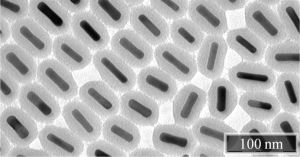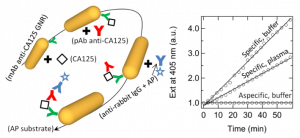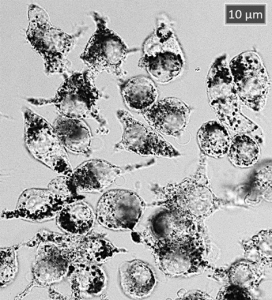Nanoplasmonics for Medicine and Robotics
Topic Leader: Fulvio Ratto
In modern times, plasmonic nanoparticles have raised wide interest for applications in fields as diverse as medicine, dioptrics and robotics, to name but a few. But their use is certainly not a recent discovery, as is witnessed by Lycurgus cup (4th century), for instance, which is a glass cup embedded with silver-gold nanoparticles yielding spectacular dichroism. Today, we know that the intense colors of plasmonic nanoparticles originate from collective oscillations of free electrons that resonate at optical frequencies.
Here, we investigate the interactions between colloidal suspensions of noble-metal nanoparticles, and in particular anisotropic gold nanoparticles resonating at near infrared frequencies, with biological systems and hybrid materials, in order to develop new applications based on optical sensing and actuation. We are particularly interested in scalable solutions that exploit the unique colorimetric, photothermic and photoacoustic features of these materials.
Synthesis of plasmonic and hybrid nanoparticles

The synthesis of plasmonic materials like anisotropic gold nanoparticles and their bio-conjugates has become an issue of topical interest. By gaining control over their size, shape and functional derivatization, it is possible to modulate their optical response in both the near and far-field, and their biochemical behavior.

We are especially focused on aqueous suspensions of so-called gold nanorods, which is cylindrical gold nanoparticles exhibiting longitudinal bands of plasmonic oscillations tunable over the entire window from below 600 to above 1200 nm with their aspect ratio, and on their modification with whatever combinations of inorganic, proteic and genetic composites. An open issue of our greatest concern is the standardization of all synthetic protocols, as a prerequisite for the translational exploitation of plasmonic and hybrid nanoparticles. In this context, for instance, we are exploring the implementation of additive manufacturing technologies to print custom reactionware, such as microfluidic bioreactors.
For more info please contact Sonia Centi and Fulvio Ratto
Main references:
-
F Ratto, P Matteini, F Rossi, R Pini, (2010) “Size and shape control in the overgrowth of gold nanorods”, J. Nanoparticle Res. 12 (6), 2029-2036 https://doi.org/10.1007/s11051-009-9712-0
Nanoplasmonics for cancer theranostics

Plasmonic nanoparticles have gained a central role in the realm of cancer nanomedicine. In particular, their use as contrast agents for the optical hyperthermia and photoacoustic imaging or microsurgery of cancer is one of those hot topics that have received nonstop interest over recent years.

The optimization of the photophysical features of these materials is a fascinating issue. But their biochemical interface probably represents the greatest challenge with open questions like how to fulfil the promise of targeted delivery to a malignant tumor, past all biological barriers, from a systemic injection?
Over the years, we have made our contribution to a broad variety of relevant issues, including the refinement of the photophysical performances of gold nanorods, and the demonstration of complementary strategies for their passive and active delivery to a tumor microenvironment. In this context, we have pioneered a futuristic approach for the implementation of bionic constructs based on the fusion between plasmonic or magneto-plasmonic nanoparticles and various types of autologous cells, such as immune-system or stem cells, that present an innate tropism toward neoplastic lesions. We believe that the recruitment of these autonomous vehicles for use as a Trojan horse may be a win-win solution to tackle the enormous intricacy of the nano-bio interface.
For more info please contact Fulvio Ratto
Main references:
- Cavigli, M. de Angelis, F. Ratto, P. Matteini, F. Rossi, S. Centi, F. Fusi, R. Pini, (2014) “Size affects the stability of the photoacoustic conversion of gold nanorods”, J. Phys. Chem. C 118 (29), 16140-16146 https://doi.org/10.1021/jp502647p
- Ratto, E. Witort, F. Tatini, S. Centi, L. Lazzeri, F. Carta, M. Lulli, D. Vullo, F. Fusi, C.T. Supuran, A. Scozzafava, S. Capaccioli, R. Pini, (2015) “Plasmonic particles that hit hypoxic cells”, Adv. Funct. Mater. 25 (2), 316-323 https://doi.org/10.1002/adfm.201402118
- Ratto, S. Centi, C. Avigo, C. Borri, F. Tatini, L. Cavigli, C. Kusmic, B. Lelli, S. Lai, S. Colagrande, F. Faita, L. Menichetti, R. Pini, (2016) Adv. Funct. Mater. 26 (39), 7178-7185 https://doi.org/10.1002/adfm.201600836
- Armanetti, A. Chillà, F. Margheri, A. Biagioni, L. Menichetti, G. Margheri, F. Ratto, S. Centi, F. Bianchini, M. Severi, R. Traversi, D. Bani, M. Lulli, T. Del Rosso, A. Mocali, E. Rovida, M. Del Rosso, G. Fibbi, A. Laurenzana (2021) “Enhanced Antitumoral Activity and Photoacoustic Imaging Properties of AuNP‐Enriched Endothelial Colony Forming Cells on Melanoma” Adv. Sci. 8 (4), 2001175 https://doi.org/10.1002/advs.202001175
Nanoplasmonics for paper-based biosensing

Plasmonic nanoparticles, and in particular gold nanoparticles, have gained tremendous momentum as colorimetric labels for paper-based sensors, as the platform of choice in the so-called rapid antigen tests for COVID-19 and a plethora of similar cases of lateral-flow immunoassays.
Here, we are exploring alternative setups to leverage on the power of anisotropic gold nanoparticles and their bio-conjugates toward the detection of proteic and genetic targets. Furthermore, we are working toward synergistic add-ons for use both up and down-stream the steps of bio-recognition, by implementing the plasmonic nanoparticles as photothermal transducers in processes of ultrafast genetic amplification, and introducing concepts of automation and machine learning for a quantitative and ultrasensitive readout of their colorimetric signals.
For more info please contact Sonia Centi
Main references:
- Centi, F. Tatini, F. Ratto, A. Gnerucci, R. Mercatelli, G. Romano, I. Landini, S. Nobili, A. Ravalli, G. Marrazza, E. Mini, F. Fusi, R. Pini, (2014) “In vitro assessment of antibody-conjugated gold nanorods for systemic injections” J. Nanobiotechnology 12 (1), 1-10 https://doi.org/10.1186/s12951-014-0055-3
Nanoplasmonics for claytronics

Claytronics is an imaginative frontier of robotics that builds upon the perspective to controllably configure and reconfigure macroscopic materials with remote stimuli, such as an optical trigger, in order to pursue the ambitious objective of programmable matter.
In this context, we are addressing reversible approaches to manipulate the local environment of plasmonic nanoparticles, and so to tune their steric configuration, with the final goal to achieve substantial control over the photophysical properties of soft matter all the way from the nano to the macroscopic lengthscale.
For more info please contact Lucia Cavigli and Fulvio Ratto
Main references:
- Mercatelli, F. Ratto, S. Centi, S. Soria, G. Romano, P. Matteini, F. Quercioli, R. Pini, F. Fusi, (2013) “Quantitative readout of optically encoded gold nanorods using an ordinary dark-field microscope”, Nanoscale 5 (20), 9645-9650 https://doi.org/10.1039/C3NR00726J
Current members:
- Fulvio Ratto (topic leader)
- Claudia Borri
- Lucia Cavigli
- Sonia Centi
- Giada Magni
- Filippo Micheletti
- Roberto Pini
- Francesca Rossi
